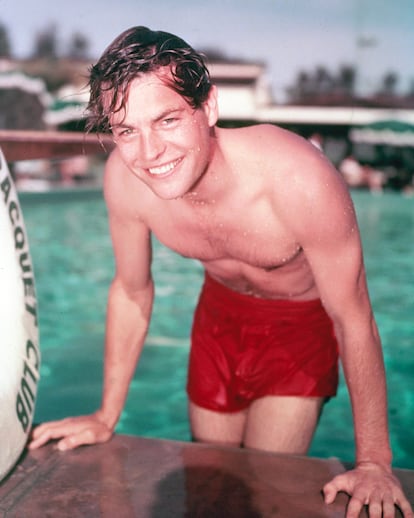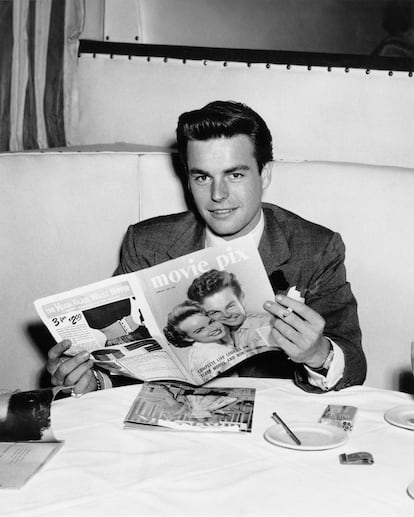Beautiful, rich, and the eternal suspect: Robert Wagner, the man who loved Natalie Wood, may know more about her death than anyone else
To mark what would have been Wood’s 85th birthday, the documentary, ‘Behind the Scenes,’ will be broadcast on TCM. The program into her legacy and the questions surrounding her disappearance

Two words hang over Robert Wagner’s career. “Prince Valiant” was the title of the 1950s adventure film that established him as the square-jawed heartthrob who the youth of half the world fell in love with, and it is also the name of the small boat that his wife, actress Natalie Wood, tried to cling to the night she died, on November 29, 1981, aged only 43. Hers is a death whose causes remain unclear four decades later, a mysterious event that continues to fuel a fascination that is now joined by a growing interest in true crime. Whether what happened that night off the Californian coast of Santa Catalina Island was a crime or an accident is something only Wagner knows. In 2018 the police again considered Wagner a “person of interest,” a term that without singling him out as a suspect places him as someone who could contribute relevant information to the case.
This July 20, when Natalie Wood would have turned 85, the TCM channel (which has programmed some of her most famous films throughout the month) will broadcast the HBO documentary Natalie Wood: What remains Behind. The film is an intimate portrait of Wood’s career and the circumstances surrounding her death, and was produced by the actress’s daughter, Natasha Gregson Wagner, who also serves as narrator. “It was important for me to make this film, because I feel that no one understands or knows my mother as well as I, my family, and my friends do,” she told EL PAÍS in 2020.
The interviews that form the backbone of the film reflect an idyllic family life and unravel a romance that seemed inevitable between two of Hollywood’s most beloved stars. Natalie Wood first stepped in front of the camera at the age of five, instigated by a controlling mother who, like so many show business parents, had poured her desires into a daughter whose life and career she could control with an iron fist. In contrast, Wood’s father was an alcoholic who left the family’s livelihood in the hands of the little girl. The young actress showed off her effortless talent in the delightful 1947 films Miracle on 34th Street, a Christmas classic, and The Ghost and Mrs Muir. She dutifully played the role of the sweet and innocent child that the studio had cast her in until she defied her mother and Hollywood at the age of 15 by playing Judy in Rebel Without a Cause (1955), a role that made her an adult in the eyes of the world. Her being cast in the role has always been at the center of controversy because of rumors that she had slept with director Nicholas Ray, 27 years her senior, to get the part.

The quality of the film and the death of James Dean a week before its release made it a worldwide phenomenon and a cult film, which, in addition to definitively confirming Wood’s talent as an actress, brought her the first of her three Oscar nominations.
The determination she showed in her career was repeated in other facets of her life. “When I grow up I’m going to marry him,” she said she thought as she first crossed paths with Robert Wagner in the halls of Fox Studios when she was 10 and he was 18. Eight years later, the dream factory worked its magic: the studio arranged a date for them on Wood’s coming-of-age day. A year later they got married in Arizona. Their romance had aroused so much interest that the windows of the church had to be covered to avoid the gazes of the hundreds of curious onlookers and journalists who crowded outside. Young and good-looking, they were magazine favorites, but while she was an established star, he couldn’t find a niche in the industry. He was handsome and not lacking in talent, but he did not dazzle. Both his dapper physique and his acting style belonged to the past: he was the ideal son-in-law, but not the dream boyfriend.
Neither rebellious nor with cause
He had rubbed shoulders with the stars while working at the Bel Air Golf Club, where he caddied for Clark Gable, and came to Hollywood through his friendship with Fred Astaire’s son, whom he met at the military academy. He was just one of many handsome young men walking around the studios waiting for someone to pick them. At his first audition he was turned down and ended up in the hands of Henry Wilson, a name that will be familiar to those who have seen Hollywood (2020), Ryan Murphy’s highly personal portrait of an industry that never existed.

Wilson was the ruthless Pygmalion who made Rock Hudson a star at the expense of his private life. He was notorious both for engineering courtships and marriages that distracted audiences from the real lives of his subjects and for sexually abusing the actors he worked with.
Unlike Wood, Wagner was not a rebel. He was the opposite of tormented actors like James Dean or Montgomery Clift. He accepted the roles he was offered, went to premieres, took whoever he was told to, and always had time to bring flowers to the queen of gossip Hedda Hopper — a fall from grace in her eyes could mean goodbye to Hollywood.
Wood, meanwhile, chose her own path. In 1961, from one of those casting decisions that are incomprehensible today, came the role that would cement her name in Hollywood: the Puerto Rican Maria in West Side Story. That same year she starred alongside Warren Beatty in Splendor in the Grass and received her first Oscar nomination for Best Actress. The prime of her career coincided with a hiatus in Wagner’s and their relationship was affected. Some people close to him claim that the cause of the actor’s lull was his wife’s affair with Beatty.

At least those were the official versions, until 2020 when Suzanne Finstand’s book Natalie Wood: The Complete Biography revealed that, before the premiere of West Side Story, one night the actress woke up in the early hours of the morning to find her husband having sex with the British butler who, for years, had accompanied her everywhere. Not only did this betrayal deal a fatal blow to their marriage, but it was always something that had hovered in the background throughout their relationship (although Finstand insists that Wood always knew of her husband’s bisexuality).
After their breakup, the romance between Wood and Beatty became official. Devastated, Wagner wanted her back. With his career at a standstill he was planning to go to Europe and asked her to accompany him. She did not. Their ways parted. As Tarantino’s Once Upon a Time in Hollywood (2019) taught us, Europe was the place where Hollywood stars could maintain a certain status, pay for their luxurious mansions, and headline billboards. Wagner also found love, married Marion Marshall, Stanley Donen’s ex-wife, and they had a daughter, but the marriage failed.

When he returned to the United States, he reconnected with Wood, who was also a parent and had walked down the aisle with producer Richard Gregson. Stability was short-lived: he cheated on her with his secretary and she threw his things out the window and filed for divorce. To the delight of those who believe in second chances, Wood and Wagner remarried. This time they were no longer teenagers that other people managed, they were adults with lives to lead. They had a daughter and their home became the epicenter of Hollywood, a happy home where their children and even the children of their ex-partners lived together.
Wood took a break from work to care for her daughters while Wagner enjoyed television success. In 1967, Lew Wasserman of Universal studio convinced him to star in his series It Takes a Thief. Wagner was initially opposed to the idea, but the producer convinced him. “I want you to be on the cover TV Guide every week. This is your medium, you have to try it, you’ll be great.” He was. In the seventies he was the most popular television face thanks to his role as an investigator in Hart to Hart (1979). He also formed the production company Rona with his wife and both were part of the development of a small project that was beginning to take shape: the series Charlie’s Angels (1976).
The end of the party
On the night that changed everything, the two were sailing their yacht with recent Oscar-winner Christopher Walken. He and Wood were filming Brainstorm (1983) at the time. It was to be the usual boat trip, lots of guests, but most had cancelled to avoid the couple’s increasingly frequent arguments. There were only the three of them and skipper Dennis Davern onboard. The version Wagner has always maintained is that, after a heated argument with Walken over Wood’s career, she retired to her cabin. Wagner exploded in anger and threw a bottle against the table. Walken left and Wagner and Davern swept up the glass and sat chatting inside the yacht. At all times he believed his wife was in the cabin. Not finding her there he returned to the deck and discovered the dinghy (Prince Valiant) in the water. The Coast Guard was alerted. At 7:45 a.m. on Sunday, November 29, a helicopter located Wood’s body floating in the water. She was dressed in her nightgown, socks and a parka.

An autopsy determined that Wood had consumed seven or eight glasses of wine before her death. She had some bruises on her arms and legs and an abrasion on her left cheek consistent with the fall. Thomas Noguchi, chief medical examiner concluded that Wood’s death was an accident. “Anyone who saw the logistics of the boat that night, that it was raining, would know exactly what happened,” Christopher Walken stated during an interview with Playboy in 1997. “People slip in the bathtub, fall down the stairs, step off the sidewalk in London because they think cars are coming the wrong way and die.”
There are other versions of what happened that night and all agree that everyone on board was very drunk and there was a loud argument, but while some claim that the reason for the argument was the romance that Walken and Wood were secretly having, for others the jealousy was in the other direction, since the lovers were Walken and Wagner.

When the case was reopened in 2011, Wagner stated that he fully supported the investigation. Seven years later, police stated, “It’s suspicious enough to make us think something happened.” Since that night, the shadow of suspicion has fallen over Wagner and has remained. But only outside his inner circle: both his daughter Courtney and stepdaughter, actress Natasha Gregson Wagner, firmly believe in his innocence. Only Lena Wood, Natalie’s sister, and the ship’s skipper Dennis Davern maintain that he was responsible. Davern has been peddling different versions of his story for years, while Wood’s sister was cut off from the family by her father after one of her boyfriends leaked photos of the couple to the press.
Nine years after Wood’s death, Wagner rebuilt his life with Jill St. John, a Bond girl in Diamonds are Forever (1971), and regained some popularity thanks to his sense of comedy in roles that seemed a parody of the kind of snooty, stuffy attitude he could never shake off. His face became popular again thanks to his role as Number Two in the Austin Powers saga (1997-2002) and Teddy Leopold in the fourth and fifth seasons of Two and a Half Men, between 2007 and 2008. He retired in 2019 and a few weeks ago, on Instagram, he thanked all those offering him congratulations on his 93rd birthday. He is often seen on the network surrounded by family members and reveling in his best role: that of model father and grandfather.
Sign up for our weekly newsletter to get more English-language news coverage from EL PAÍS USA Edition
Tu suscripción se está usando en otro dispositivo
¿Quieres añadir otro usuario a tu suscripción?
Si continúas leyendo en este dispositivo, no se podrá leer en el otro.
FlechaTu suscripción se está usando en otro dispositivo y solo puedes acceder a EL PAÍS desde un dispositivo a la vez.
Si quieres compartir tu cuenta, cambia tu suscripción a la modalidad Premium, así podrás añadir otro usuario. Cada uno accederá con su propia cuenta de email, lo que os permitirá personalizar vuestra experiencia en EL PAÍS.
¿Tienes una suscripción de empresa? Accede aquí para contratar más cuentas.
En el caso de no saber quién está usando tu cuenta, te recomendamos cambiar tu contraseña aquí.
Si decides continuar compartiendo tu cuenta, este mensaje se mostrará en tu dispositivo y en el de la otra persona que está usando tu cuenta de forma indefinida, afectando a tu experiencia de lectura. Puedes consultar aquí los términos y condiciones de la suscripción digital.
More information
Archived In
Últimas noticias
Most viewed
- Sinaloa Cartel war is taking its toll on Los Chapitos
- Oona Chaplin: ‘I told James Cameron that I was living in a treehouse and starting a permaculture project with a friend’
- Reinhard Genzel, Nobel laureate in physics: ‘One-minute videos will never give you the truth’
- Why the price of coffee has skyrocketed: from Brazilian plantations to specialty coffee houses
- Silver prices are going crazy: This is what’s fueling the rally











































